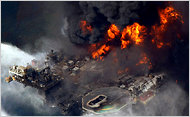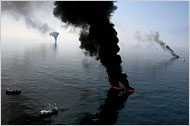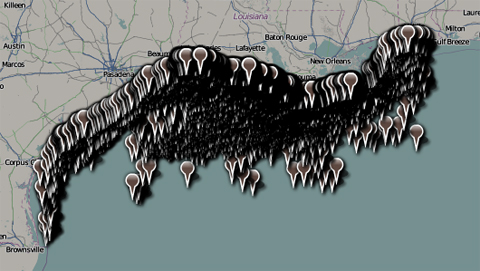.
As BP and its team prepare to seal the wrecked Macondo well with mud and cement early next week, and the extent of oil on the surface of the Gulf of Mexico has receded, biologists and other scientists are mulling the long-term prospects for the ecosystems of the despoiled region and the communities that rely on them.
I e-mailed a batch of researchers and other experts tracking the aftermath of the gulf gusher and others who studied previous oil spills to get their sense of where things go from here. Their responses are posted below (along with a musical take on the situation by Pete Seeger).
In the long run — as happened in the world’s worst oil spill, in the Persian Gulf during the war — ecosystems will heal and even thrive. But big questions persist for now.
While the risk to coasts is likely to quickly recede, biologists have expressed strong concerns about the use of nearly 2 million gallons of chemical dispersants that don’t destroy surface slicks, but simply cause the oil to disperse and sink (not to mention the dispersants sprayed at the point where oil gushed from the seabed a mile down).
A Greenwire report published in the The Times put it this way:
That dispersed oil now hovers, diluted in the water column, posing a challenge for scientists to track and measure the subsea plumes. Mapping the long-term effects of the nearly 2 million gallons of dispersant used by BP PLC may well be equally difficult, given the array of unanswered questions that surround the products’ rapid breakdown of oil droplets and their chronic toxicity.
In other words, while dispersants may have helped spare the Gulf’s birds, the chemicals are likely shifting dangers to other species lower in the food chain. The National Research Council described dispersant use in 2005 as “a conscious decision” to direct hydrocarbons to one part of the marine ecosystem, “decreasing the risk to water surface and shoreline habitats while increasing the potential risk to organisms in the water column and on the seafloor.” Read the rest…
Here are the thoughts of some scientists and chroniclers of this and past oil spills, including the Exxon Valdez incident in 1989:
Eric Cordes, Temple University:
I think we still have a lot of “I don’t knows.” The oil on the surface appears to be going away. I am sure that there are plenty of people that would tell you that it has not disappeared from the marshes and shorelines of the northern Gulf. As Jane Lubchenco said, it does not appear to be sitting on the bottom, at least in the areas that have been surveyed. That doesn’t mean that there has been no impact on those deep-water coral or seep communities. There is a lot of evidence that the dissolved hydrocarbons and a fine mist of oil droplets are moving around at depth in plumes below 1000 meters.
We have not yet been to those depths to survey the communities that we know about – mostly natural oil seep communities, some within 6 miles of the Deepwater Horizon — to see if they have been impacted. Besides the immediately visually detectable impacts, this could also have long term affects on growth and reproduction that will take a long time to evaluate and monitor.We (Chuck Fisher and I, and others) hope to get out there soon to have a look. Until then, it is another big “I don’t know.”
Caz Taylor, Tulane University:
We have been seeing droplets of what could be oil or dispersant (or both) in crab larvae, from Pensacola, Fla., all the way down into Galveston, Tex. We haven’t yet confirmed what these droplets are but, if they are oil-spill related, then we have been seeing effects of the oil spill in places where oil is not visible for a while now. So the (welcome) news that the surface oil is receding does not greatly change my perception of the magnitude of the effects of the spill. There is still a lot of oil out there. If the oil and/or dispersant has entered the food web then the effects will be felt throughout the Gulf although they may take months, or longer, to manifest themselves.
With regards to whether the effects will be socioeconomic versus ecological, etc., it’s difficult to separate them when considering harvested species. We know that the one spill in the Gulf of comparable magnitude, from the Ixtoc well, resulted in a severe depression in marine populations, particularly shrimp. The stock took years to recover and the regional fishery never really recovered for a set of complex reasons. I recently moved to New Orleans, and it seems to me that this town and most of the region runs on local seafood. I think of the multiple effects of the collapse of the blue crab population and fishery in Chesapeake Bay. A similar decline of Gulf blue crabs, shrimp or any of our Gulf fisheries would be a cultural, sociological, economic and ecological tragedy.
Charles Wohlforth, a journalist who covered the Exxon Valdez spill and author of “The Fate of Nature”:
The Exxon Valdez oil spill offers a valuable lesson for predicting the long term harm of BP’s spill, teaching caution about the limits of our knowledge in a big, dynamic marine ecosystem. We still don’t know the true impact of Exxon Valdez, and now it is clear we never will. The immediate wildlife deaths in Alaska appear to have been orders of magnitude worse — a quarter million birds and otters compared to less than 2,000 animals so far confirmed dead from the Gulf. But measuring long-term damage requires understanding how pollutants work their way through water, sediments and the food web over time. That’s much harder than counting dead animals.
The ecosystem effects of pollution range from the nearly imperceptible, in depressed growth or reproduction of particular species, to the incomprehensible, as when the web of life is restructured because an important element of the old regime is disabled. If the impact of such a change is on the resilience rather than the productivity of the system, the damage may not be evident until much later, when the ecosystem collapses for a seemingly unrelated cause.
It’s clear the Sound ecosystem is profoundly different than it was before the oil hit 21 years ago. But scientists can’t tell us why, or exactly what the changes mean.
Throughout the crisis in the Gulf of Mexico officials have shown a lack of humility before the power and complexity of nature. Understanding the long term harm of the spill will require a major investment of time and money in a broad-ranging, well designed science program. And an acceptance that the only simple answer may be that oil spills must be prevented.
Ian MacDonald, Florida State University:
The human system through the northeastern Gulf of Mexico has experienced what can only be called a sympathetic reaction to the dragged out trauma that hit the Gulf’s marine and coastal ecosystem. The effects are undeniable. We know this because we’ve all felt the pain of the oiled birds and stained beaches over these past 100 days — everyone in the country, but those keenest who were closest to it. The question is how do we respond now that the acute phase is past? How do we assess and mitigate the damage done?
The recent satellite data indicate that although the oil has greatly diminished in the 15+ days since the gusher was staunched, patches of floating oil remain in the open Gulf and will continue to come ashore in the weeks to come — albeit in isolated patches of tarballs and coagulated mats. The decrease in volume of the floating oil is predicted by models from NOAA and others. A light sweet crude from Mississippi Canyon, floating on the Gulf of Mexico during summer conditions, will have a half life of 7 to 5 days. So it is not surprising that a great deal of oil “disappeared” once the flow of oil stopped.
However, as the time course of evaporation and dissipation continues, the material that remains will be more and more durable and persistent. Moreover, much the hydrocarbon that “disappears” is still in the environment following evaporation into the air, dissolution into the water, or burial in marine and coastal soils. BP and the authorities will smear that remaining material around and will recover a fraction of it. Ultimately, however, a combination of bacteria and environmental chemistry will oxidize everything except for the very durable residuals. That material, judging from past events, will remain for decades.
Thinking about this on a decadal scale, how do we repay the ocean for having cleaned up our mess? How do we make good on the great sympathetic trauma we all experienced? BP has pledged to make things right for the people of the region who have suffered economically. Under Obama’s pressure, they set aside $20 billion and will pay out more still more to settle law suits. Beyond all that, BP is facing a whopping fine — at least $5 billion and possibly as much as $20 billion!
Here’s a suggestion. That fine should be placed in a permanent trust to restore, understand, and sustain the Gulf of Mexico marine and coastal ecosystem. It should not be used to repay hotel owners or plug state deficits. We owe it to the gulf we love.
Sylvia Earle, oceanographer, National Geographic Society:
Applause to Ian MacDonald for this thoughtful analysis, and for the bottom line: We must take measures to “give back to the Gulf.”
We can speculate knowledgeably about the consequences to the future of the Gulf of Mexico, but there is no way to fully gauge the impacts on any single species, let alone the entire system, but one conclusion is clear. Pouring millions of gallons of oil and dispersants into an area already greatly stressed by upstream pollution, atmospheric fall-out, fifty years of industrial activity (44,000 wells, 33,000 miles of pipelines), shoreline
trauma, and ecosystem damage by decades of large-scale fishing is a recipe for short and long-term disaster.
To compensate the Gulf, and provide hope for recovery, actions should be taken asap to identify and protect areas that are still in good shape. This is the key. Obama has the power to do as Presidents T. Roosevelt and Bush have done in the past — under the Antiquities Act — to declare National Monuments. What better way to “give back to the Gulf” — and to the people whose livelihood depend on a healthy Gulf — than to protect the deep reefs and string of “topographic highs” in the Northern Gulf, the spawning areas for tuna, the critical places for menhaden, grouper, snapper, shrimp and others, as well as the vital — but neglected — seagrass meadows of Florida’s Big Bend area, from Panama City to Tampa Bay. Respect for the importance of the floating forests of Sargassum and their role in providing nursery areas, food and shelter — as well as taking up carbon and generating oxygen — might be considered in an overall recovery plan. This could be the moment to act to secure protection for Pulley Ridge, the extraordinary system of deep reefs 150 miles offshore from Sarasota.
New research and on-going monitoring is critical and would be a smart way to invest funding derived from whatever “restitution” comes from the current oil spill. However, knowledge already exists concerning where the critical areas are, based on years of existing research. In the past, moves to protect the Gulf have been timid at best. The Flower Garden Banks as a sanctuary is a jewel, and the small areas established for full protection within the Florida Keys National Marine Sanctuary are helpful, but the serious scale of the present assault requires serious — and rapid — response.
I applaud the usual multi-year process required to establish marine protected areas, with long deliberations, public hearings and resulting multiple-use “Management areas” — a small but promising network of marine sanctuaries for the nation. It has worked in the past to acquire “buy in” from a broad public constituency, largely driven by a desire to placate those who want to continue fishing and other extractive uses. But in the Gulf, the amount of ocean truly protected (where even fish, shrimp and lobsters are safe) is a slim thread upon which to hang overall ecosystem integrity, let alone recovery from the latest blows. And time is of the essence.
Numerous proposals for establishing protected areas in the Gulf have been put forward over the years. Maybe now is the time, when the need is so obvious, to act on them.
There’ll be a lot more discussion of the long-term fate of the Gulf in months to come. In the meantime, make sure to watch this short video clip below from a forthcoming documentary, Mission Blue, which shows Earle’s recent trip to check on the status of whale sharks in the Gulf. These extraordinary fish feed on the surface and are considered particularly vulnerable to oil (although the sharks in this encounter were doing just fine:
.
Also, Pete Seeger, at 91, has weighed in with a new contribution to the growing list of songs related to the gulf spill:
.
When we look and we can see things are not what they should be
God’s counting on me, God’s counting on you
When we look and see things that should not be
God’s counting on me, God’s counting on you
Hopin’ we’ll all pull through, Hoping we’ll all pull through,
Hopin’ we’ll all pull through
Me and you.
It’s time to turn things around, trickle up not trickle down
God’s counting on me, God’s counting on you
It’s time to turn things around, trickle up not trickle down
God’s counting on me, God’s counting on you
Hopin’ we’ll all pull through, Hoping we’ll all pull through,
Hopin’ we’ll all pull through
Me and you.
And when drill, baby, drill turns to spill, baby, spill
God’s counting on me, God’s counting on you
Yes when drill, baby, drill turns to spill, baby, spill
God’s counting on me, God’s counting on you
Hopin’ we’ll all pull through, Hoping we’ll all pull through,
Hopin’ we’ll all pull through
Me and you.
Don’t give up don’t give in, workin’ together we all can win
God’s counting on me, God’s counting on you
Don’t give up don’t give in, workin’ together we all can win
God’s counting on me, God’s counting on you
Hopin’ we’ll all pull through, Hoping we’ll all pull through,
Hopin’ we’ll all pull through
Me and you.
There’s big problems to be solved, let’s get everyone involved
God’s counting on me, God’s counting on you
There’s big problems to be solved, let’s get everyone involved
God’s counting on me, God’s counting on you
Hopin’ we’ll all pull through, Hoping we’ll all pull through,
Hopin’ we’ll all pull through
Me and you.
When we sing with younger folks, we can never give up hope
God’s counting on me, God’s counting on you
When we sing with younger folks, we can never give up hope
God’s counting on me, God’s counting on you
Hopin’ we’ll all pull through, Hoping we’ll all pull through,
Hopin’ we’ll all pull through
Me and you.
Below you can watch a more home-style rendition of the tune, recorded just up the Hudson River from my home, at the Beacon Sloop Club (if you live in the region, make sure to come by for the monthly potluck supper, meeting and musical jam session, the first Friday evening of each month):



















 Apture allows readers to dig deeper into a subject without ever leaving the blog post. When you click on any link marked by the icons
Apture allows readers to dig deeper into a subject without ever leaving the blog post. When you click on any link marked by the icons 

